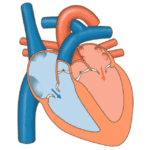Components of the Circulatory System
The circulatory system consists of the heart, blood vessels, and blood. The heart is a muscular organ that pumps blood through two primary circuits:
- Pulmonary circulation: Blood travels from the heart to the lungs to pick up oxygen and back to the heart.
- Systemic circulation: Blood delivers oxygen and nutrients to the rest of the body.
Blood vessels include:
- Arteries: Carry oxygen-rich blood away from the heart.
- Veins: Bring oxygen-poor blood back to the heart.
- Capillaries: Tiny vessels where oxygen and nutrients are exchanged with cells.
The Role of Blood in Circulation
Blood is made up of:
- Red blood cells: Transport oxygen using hemoglobin, a protein that gives blood its red color when bound to oxygen.
- White blood cells: Defend the body against infections.
- Platelets: Help in clotting when you’re injured.
- Plasma: The liquid part carrying nutrients, hormones, and waste.
When blood does not flow to an area of the body, that area doesn’t receive oxygen and nutrients, causing cells to die and leading to severe damage.
The circulatory system works closely with the respiratory system to exchange oxygen and carbon dioxide.
The Heart’s Incredible Power
Through powerful and rhythmic contractions, the heart pumps blood to your entire body in just a minute.
The Cycle Starts: The right side of the heart receives oxygen-poor blood from the body and pumps it to the lungs to pick up oxygen.
Oxygen-Packed Blood Returns: The left side of the heart receives the oxygen-rich blood from the lungs.
Strong Pumping Power: The left ventricle, the strongest chamber of the heart, contracts forcefully to push oxygen-rich blood into the aorta, the largest artery.
Blood Travels Fast: The aorta branches into smaller arteries, carrying blood to every organ and cell.
Repeat Cycle: This process happens quickly and efficiently—beating around 70–100 times a minute.
Fun Facts
Here are some interesting facts about the Circulatory System:
- Your heart beats about 100,000 times daily, pumping around 2,000 gallons of blood!
- Blood only takes about 20 seconds to travel around your entire body.
- A single drop of blood contains about 5 million red blood cells!
- The sound of your heartbeat, “lub-dub,” is actually the sound of your heart valves opening and closing as blood flows through!
Review
Let’s quickly recap what we learned about the Circulatory System:
- What are the two main types of circulation in the body? Pulmonary, Systemic
- What are the three types of blood vessels? Arteries, Veins, Capillaries
- What carries oxygen in red blood cells? Hemoglobin
- How long does it take for blood to circulate the entire body? 20 Seconds


Recent Comments